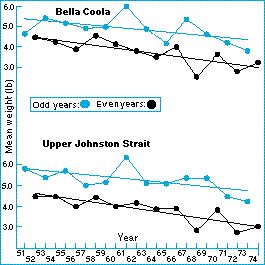Natural selection and variation - What are the types of natural selection?

An example of directional selection: pink salmon
Pink salmon (Onchorhynchus gorbuscha ) in the Pacific Northwest have been decreasing in size in recent years. In 1945, fishermen started being paid by the pound, rather than per individual, for the salmon they caught and they increased the use of gill netting, which selectively takes larger fish. After gill netting was introduced, smaller salmon had a higher chance of survival; the selection favoring small size in the salmon population was intense, because fishing is thorough: about 75 - 80% of the adult salmon swimming up the rivers under investigation were caught in these years. The average weight of salmon duly decreased, by about one-third, in the next 25 years.
Figure: the graph shows the decrease in size of pink salmon in two rivers in British Columbia. Two lines are drawn for each river: one for the salmon caught in odd-numbered years, the other for even years. Salmon caught in odd years are presumably heavier because of the two year life cycle of the salmon. From Ricker (1981).
| Next |



